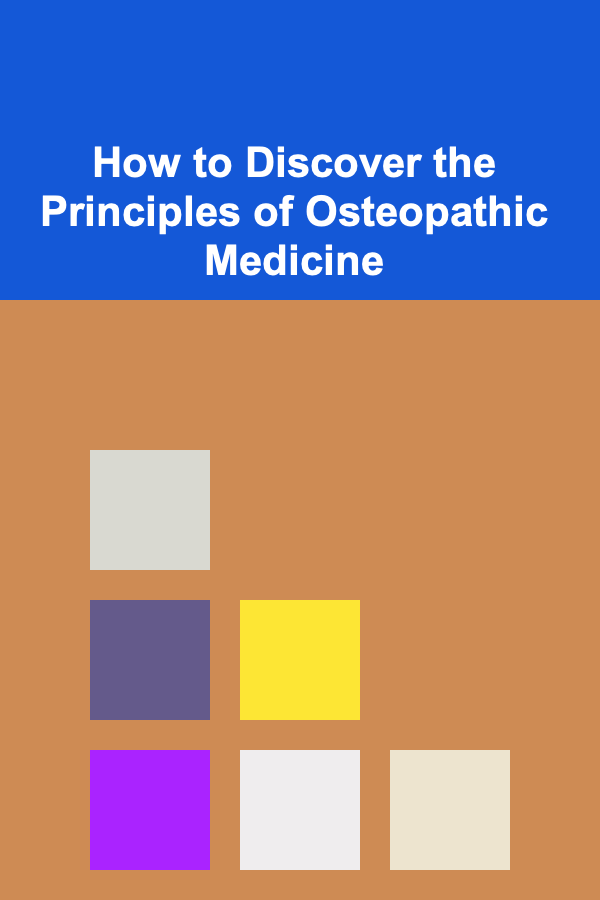
How to Discover the Principles of Osteopathic Medicine
ebook include PDF & Audio bundle (Micro Guide)
$12.99$7.99
Limited Time Offer! Order within the next:

Osteopathic medicine is a distinctive branch of healthcare that focuses on the interrelationship between the body's structure and its function. Established by Dr. Andrew Taylor Still in the late 19th century, osteopathy has grown into a global practice with a strong emphasis on preventive care and the body's inherent ability to heal itself. In this article, we will explore how to discover the principles of osteopathic medicine, its historical background, core philosophies, and its application in modern-day healthcare.
Understanding Osteopathic Medicine
Osteopathic medicine is based on the belief that the body functions as a unit, and that its structure---bones, muscles, organs, and tissues---plays a critical role in the way it functions. Unlike conventional medicine, which often addresses symptoms in isolation, osteopathic medicine views health in a holistic context. The primary goal of osteopathic practice is to restore balance and harmony to the body, enabling it to heal itself.
The principles of osteopathic medicine are rooted in the philosophy that the body has an innate ability to maintain health and well-being. By understanding these principles, practitioners can support this natural healing process through manual therapy, lifestyle adjustments, and a comprehensive approach to diagnosis and treatment.
Historical Foundations of Osteopathic Medicine
The roots of osteopathic medicine trace back to the late 1800s, when Dr. Andrew Taylor Still, a physician and surgeon, developed the practice in response to the limitations of conventional medical treatments of the time. Dr. Still was disillusioned by the lack of effective treatments for conditions like pneumonia and infectious diseases. He sought a more holistic approach that considered the body's inherent ability to self-regulate and heal.
Dr. Still's philosophy was revolutionary. He introduced the idea that the body's musculoskeletal system was not only essential for movement, but also for the function of internal organs. He emphasized the importance of maintaining a healthy spine and musculoskeletal system, believing that any dysfunction in these areas could lead to disease.
In 1892, Dr. Still founded the American School of Osteopathy (ASO) in Kirksville, Missouri, marking the official birth of osteopathic medicine. His teachings laid the foundation for what would become a unique form of medical practice, now practiced worldwide. Over the years, osteopathic medicine has evolved, but the core principles remain the same.
The Core Principles of Osteopathic Medicine
Osteopathic medicine is based on four primary principles. These principles guide the osteopathic approach to patient care, diagnosis, and treatment. Understanding these principles is key to discovering how osteopathic medicine works and why it is such an effective form of healthcare.
1. The Body is a Unit
The first principle of osteopathy is that the body functions as a unit. This means that all the parts of the body---muscles, bones, organs, and tissues---are interconnected and interdependent. In osteopathic medicine, practitioners understand that the body's structure directly influences its function. For instance, a misalignment in the spine or a restriction in the musculoskeletal system can affect the function of other systems in the body, including the cardiovascular, digestive, and respiratory systems.
This holistic view of the body is one of the defining characteristics of osteopathic medicine. Unlike traditional medicine, which often treats specific symptoms or diseases in isolation, osteopathic medicine aims to restore overall balance by addressing the root causes of dysfunction.
2. The Body Has Self-Healing Mechanisms
The second principle emphasizes the body's innate ability to heal itself. Osteopathic medicine believes that the body has the natural ability to maintain health, and when it is in balance, it can fight off illness and injury. The role of the osteopathic physician (DO) is to facilitate this natural healing process by using a range of treatments, including manual therapy, exercise, and lifestyle changes.
The self-healing power of the body is one of the key reasons why osteopathic medicine places such an emphasis on prevention. By maintaining good structural health and promoting a healthy lifestyle, the body is better equipped to prevent disease and recover from injuries.
3. Structure and Function Are Interrelated
Osteopathic medicine posits that the structure of the body---its bones, muscles, and tissues---directly affects its function. This is the third principle of osteopathy. A body that is properly aligned and free of restrictions in movement will function more effectively. On the other hand, dysfunction in the musculoskeletal system can interfere with the body's ability to perform its normal functions.
For example, misalignments in the spine (such as subluxations) can put pressure on nerves, leading to pain and dysfunction in other parts of the body. By restoring proper alignment through osteopathic manipulative treatment (OMT), osteopathic physicians aim to optimize the body's structural integrity and enhance its function.
4. The Role of the Physician is to Facilitate Health
The fourth principle emphasizes the role of the osteopathic physician in facilitating health. Rather than simply diagnosing and treating illness, osteopathic physicians (DOs) focus on promoting overall wellness. They take a comprehensive approach to patient care, looking at factors such as diet, exercise, stress levels, and lifestyle choices. By addressing all aspects of health, osteopathic physicians aim to help patients achieve optimal wellness and prevent disease before it starts.
Osteopathic physicians also use manual techniques, such as osteopathic manipulative treatment (OMT), to restore balance and enhance the body's ability to heal itself. OMT involves the use of the hands to diagnose, treat, and prevent conditions related to the muscles, bones, and joints.
How to Discover the Principles of Osteopathic Medicine
Now that we've explored the foundational principles of osteopathic medicine, let's discuss how you can discover and apply these principles in your own life or practice.
1. Education and Training
The first step in discovering the principles of osteopathic medicine is through education and training. If you are interested in becoming an osteopathic physician, you will need to complete an accredited medical school program. In the United States, this typically involves attending a College of Osteopathic Medicine (COM), where you will receive extensive training in both conventional medical practices and osteopathic principles.
The training at a COM includes both classroom instruction and clinical experience. Students learn anatomy, physiology, pathology, pharmacology, and other core medical sciences. In addition, they are trained in osteopathic manipulative treatment (OMT), a set of hands-on techniques used to diagnose and treat musculoskeletal conditions. Upon graduation, students must pass licensing exams before they can practice as licensed osteopathic physicians.
Even if you don't wish to become a DO, you can still learn about osteopathic medicine through various resources, such as books, articles, and online courses. Many osteopathic organizations also offer workshops and seminars to help the public understand osteopathic principles.
2. Understanding Osteopathic Manipulative Treatment (OMT)
One of the best ways to discover the principles of osteopathic medicine is by learning about and experiencing osteopathic manipulative treatment (OMT). OMT is a hands-on technique used by osteopathic physicians to diagnose, treat, and prevent conditions that affect the muscles, bones, and joints. It is a key aspect of osteopathic practice and embodies many of the core principles, including the body's interrelated structure and function, as well as its ability to heal itself.
OMT can be used to treat a variety of conditions, including musculoskeletal pain, headaches, digestive issues, and respiratory problems. By using their hands to manipulate the body, osteopathic physicians aim to restore balance and promote healing.
If you are interested in experiencing OMT, you can consult with an osteopathic physician (DO) in your area. Many osteopathic clinics offer OMT as part of their treatment options.
3. Embracing Preventive Care
Preventive care is another core principle of osteopathic medicine. Osteopathic physicians emphasize the importance of maintaining good health through lifestyle choices, such as exercise, nutrition, and stress management. They take a proactive approach to health, helping patients avoid illness rather than simply treating it once it occurs.
To discover the principles of osteopathic medicine in your daily life, you can start by adopting a more preventive mindset. Focus on maintaining a healthy diet, getting regular exercise, managing stress, and getting enough sleep. These simple changes can have a significant impact on your overall health and well-being.
4. Experiencing Holistic Healthcare
Finally, discovering the principles of osteopathic medicine involves experiencing a holistic approach to healthcare. Osteopathic physicians treat the whole person, not just the symptoms of a particular disease. They take into account the physical, emotional, and social aspects of health, and strive to address the root causes of illness rather than just managing symptoms.
By seeking out healthcare providers who adopt a holistic approach, you can begin to experience the benefits of osteopathic medicine. Look for providers who emphasize preventive care, stress the importance of self-healing, and consider all aspects of your well-being when diagnosing and treating illness.
Conclusion
Osteopathic medicine is a comprehensive, patient-centered approach to healthcare that focuses on the interrelationship between the body's structure and function. The core principles of osteopathy---body unity, self-healing, structure-function interrelationship, and the physician's role in facilitating health---serve as the foundation for osteopathic practice.
To discover the principles of osteopathic medicine, you can pursue formal education, experience osteopathic manipulative treatment (OMT), embrace preventive care, and seek holistic healthcare providers. By adopting these principles in your life, you can enhance your overall health, prevent disease, and harness the body's inherent ability to heal itself.
As osteopathic medicine continues to evolve and integrate with conventional medical practices, its holistic, patient-centered approach will undoubtedly play a significant role in shaping the future of healthcare. Through continued exploration and application of osteopathic principles, we can look forward to a world where optimal health and well-being are accessible to all.
Reading More From Our Other Websites
- [Organization Tip 101] How to Use Shelf Risers for Maximizing Space
- [Home Staging 101] How to Stage a Kitchen Island to Impress Every Buyer
- [Organization Tip 101] How to Create a DIY Photo Wall Display
- [Screen Printing Tip 101] Creative Techniques to Make Your Designs Pop on Dark Apparel
- [Home Lighting 101] How to Incorporate Natural Light into Your Home Decor
- [Personal Investment 101] How to Build a Passive Income Stream with Deep Learning Projects
- [Home Security 101] How to Start or Join a Neighborhood Watch Program for Better Community Security
- [Whitewater Rafting Tip 101] Best Whitewater Rafting Tours for Paddleboarders & River Explorers
- [Ziplining Tip 101] Best Zipline Safety Gear Rental Services with Flexible Return Policies in Southeast Asia
- [Home Security 101] How to Secure Your Home When Moving into a New Property

How to Create a System for Organizing Your Recipes Online
Read More
How to Maximize Space in Your Apartment with Foldable Furniture
Read More
How to Set Up a DIY Family Indoor Camping Experience
Read More
How To Program Humanoid Robots for Basic Actions
Read More
10 Tips for Managing Small Business Cash Flow
Read More
10 Essential Elements of a Complete Music Practice To-Do List
Read MoreOther Products

How to Create a System for Organizing Your Recipes Online
Read More
How to Maximize Space in Your Apartment with Foldable Furniture
Read More
How to Set Up a DIY Family Indoor Camping Experience
Read More
How To Program Humanoid Robots for Basic Actions
Read More
10 Tips for Managing Small Business Cash Flow
Read More